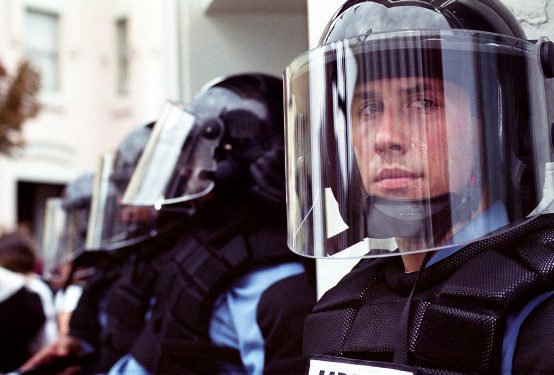Will the Panopticon Save Us From the Police?

Since the shooting of Michael Brown by a Ferguson, Missouri police officer over a week ago, the idea of arming police with personal body cameras to record their on-duty actions has gained fresh currency.
German Lopez at Vox wrote, “If police officers were required to wear body cameras, questions about their conduct — like the ones that have arisen in the wake of the Michael Brown shooting — could be avoided.” Derek Thompson at The Atlantic noted, “Although military technology has arguably given law enforcement an unreasonable amount of power, there is another piece of technology that could help restrain the militarization of America’s police in the future: a camera.” And Nick Gillespie of Reason insisted that “While there is no simple fix to race relations in any part of American life, there is an obvious way to reduce violent law enforcement confrontations while also building trust in cops: Police should be required to use wearable cameras and record their interactions with citizens.”
The idea is to attach small, portable cameras to police officers’ collars or sunglasses that can then provide objective evidence to be called upon to settle any disputes or complaints about misconduct. The California city of Rialto has been conducting a rigorous and increasingly high-profile police body camera experiment over the past couple years, and has found results to exceed what expectations even their staunchest advocates could likely have had. As the New York Times reported a year ago,
In the first year after the cameras were introduced here in February 2012, the number of complaints filed against officers fell by 88 percent compared with the previous 12 months. Use of force by officers fell by almost 60 percent over the same period.
Officers had been randomly assigned cameras and instructed to turn them on for any encounter with civilians. The Times continued, “Officers used force 25 times, down from 61 over the previous 12 months. And those wearing cameras accounted for 8 of those incidents.” The Rialto police chief William A. Farrar observed, “When you put a camera on a police officer, they tend to behave a little better, follow the rules a little better … And if a citizen knows the officer is wearing a camera, chances are the citizen will behave a little better.”
Yet even setting aside the natural privacy concerns raised by strapping recording devices to every patrol officer circumambulating their city’s streets, it is worth raising a smaller, subtler, but nevertheless potentially significant concern: the increasingly intermediated cop. One only has to glance in the window of a local patrol car to see the sprawling array of screens, keyboards, and communication devices designed to link the officer to all the information they could need. The problem being, of course, that the most important information the common cop needs still can’t be pulled up within his car: the knowledge gained from building relationships with those in the community he patrols.
That relationship-building is a core component of a police officer’s mission, and may be almost entirely divorced from the work he can get done on his car’s mounted notebook computer. It also requires a certain amount of discretion, getting to know a neighborhood’s warts as well as its virtues. The conversations that give an officer an accurate picture of the seedy but not destructive side of his citizens’ lives could very well be more difficult or awkward should the policeman’s sunglasses be rolling film.
Mark Steyn, in addressing the more expressly dangerous and frightening distortion of the police seen in the militarization of the Ferguson PD, gave some interesting and relevant history:
To camouflage oneself in the jungles of suburban America, one should be clothed in Dunkin’ Donuts and Taco Bell packaging. A soldier wears green camo in Vietnam to blend in. A policeman wears green camo in Ferguson to stand out – to let you guys know: We’re here, we’re severe, get used to it.
This is not a small thing. The point about ‘the thin blue line’ is that it’s blue for a reason. As I wrote a couple of months ago:
‘The police’ is a phenomenon of the modern world. It would be wholly alien, for example, to America’s Founders. In the sense we use the term today, it dates back no further than Sir Robert Peel’s founding of the Metropolitan Police in 1829. Because Londoners associated the concept with French-style political policing and state control, they were very resistant to the idea of a domestic soldiery keeping them in line. So Peel dressed his policemen in blue instead of infantry red, and instead of guns they had wooden truncheons.”
So, when the police are dressed like combat troops, it’s not a fashion faux pas, it’s a fundamental misunderstanding of who they are.
When the police are moving around dressed as Google Glassholes, might they also be living a misunderstanding? Body cameras may ultimately be necessary to protect us from the police, and the police from themselves. But the Benthamite logic that keeps our present-day peace will be fundamentally different from that governing the polis-protectors of Sir Robert Peel.
Comments